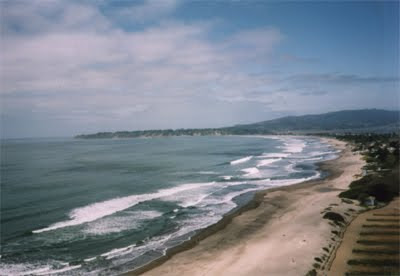
I'm reading an entertaining novel --
White Teeth -- by the young and talented Zadie Smith. I've come across a passage that made me pause.
"To Alsana's mind the real difference between people was not colour. Nor did it lie in gender, faith, and their relative ability to dance a syncopated rhythm or open their fists to reveal a handful of gold coins. The real difference was far more fundamental. It was in the earth. It was in the sky. You could divide the whole of humanity into two distinct camps, as far as she was concerned, simply by asking them to complete a very simple questionnaire:
a) Are the skies you sleep under likely to open up for weeks on end?
b) Is the ground you walk on likely to tremble and split?
c) Is there a chance (and please tick the box, no matter how small that chance seems) that the ominous mountain casting a midday shadow over your home might one day erupt with no rhyme or reason?
Because if the answer is yes to one or all of these questions, then the life you lead is a midnight thing, always a hair's breadth from the witching hour; it is volatile, it is threadbare; it is carefree in the true sense of that term; it is light, losable like a keyring or a hairclip. And it is lethargy: why not sit all morning, all day, all year, under the same cypress tree drawing the figure of eight in the dust? More than that, it is disaster, it is chaos: why not overthrow the government on a whim, why not blind the man you hated, why not go mad, go gibbering though the town like a loon, waving your hands, tearing your hair? There's nothing to stop you -- or rather anything could stop you, any hour, any minute. That feeling. That's the real difference in a life. People who live on solid ground, underneath safe skies, know nothing of this; they are like the English POWs in Dresden who continued to pour tea and dress for dinner, even as the alarms went off, even as the city became a towering ball of fire."
As fires rage in California tonight and in the light of this weekend's Red, White and Brave parade, when the world can't get enough of the Antioch kidnapping, I wonder about the relationship of disaster to the ability to really, actively live life. I wonder how I might answer this quiz (all yeses) and what that says about me. Granted, I didn't grow up in Alsana's Bengal; I haven't lived through war and only the tiniest of earthquakes. But I do believe that anything could happen. The skies could open up, the ground could tremble. An alien could abduct me. I could fall in love and/or become destitute. I could be murdered or permanently disfigured. I could be washed in rainbow light and dance with leprechauns forever and ever.
The basis for my yeses is not that I'm privy to frequent disaster, it's that I cherish imagination and am willing (eager!) to be surprised; thus, it seems to me that there is a third kind of person. In this third space between privilege and disaster, between indolence and reaction, there is a sense of incredibly terrifying possibility. Certainly in the realm of building impossible things -- experimental art outposts, communally owned land, relationships that work and art that matters -- we must cultivate a threadbare sense of self and a carefree attachment to how things turn out. I'm learning that an alternative lifestyle can be volatile; it's tenuous and scary to do things differently. We could be jailed or commodified or shut down or hurt. Yet this love affair with that midnight thing... it's what keeps us believing in possibilities.


























